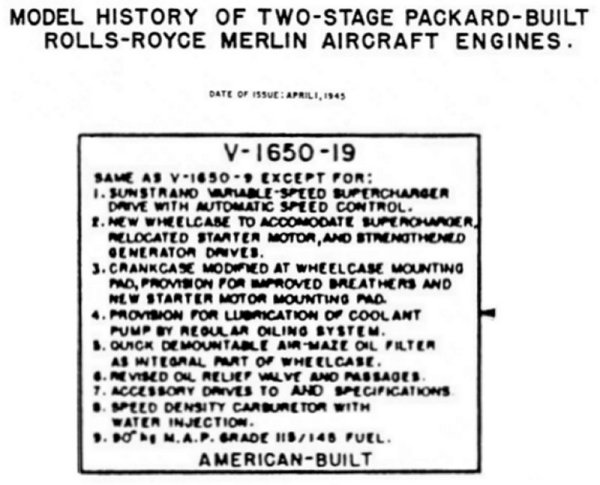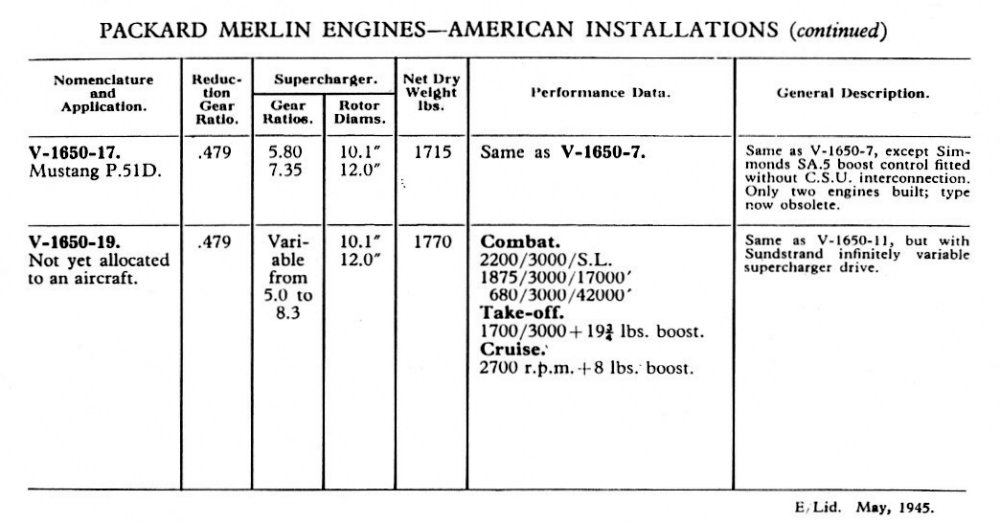
Note that the word "Sundstrand" has been spelt incorrectly.
The Packard Variable Speed Drive
by Jerry Wells
| This article was written as an appendix to "Packard Merlin Supercharger Drive Mechanism for Two-Stage
Engines", published in Torque Meter Vol 1, No 4 and Vol 2, No 1. The author hopes it will jog somebody's memory and produce more information on this most interesting compressor device. |
 |
| Table 1. Extract from a Packard Co. list giving the main features of the V-1650-19. Note that the word "Sundstrand" has been spelt incorrectly. |
One of the intriguing listings in the Rolls-Royce engine data sheets is that detailing the Packard-Merlin V-1650-19 version (see Table 2).
Packard engine data sheets claim that two examples of the V-1650-19 were built and the inclusion of performance figures in Table 2 confirm this as does the weight listing of 1770 lbs which makes it the heaviest Merlin model ever manufactured.
 |
| Table 2. Extract from a Rolls-Royce engine list giving details of the V-1650-19 performance. For some reason, the fact that this model was intended to be operated at +30 lb boost (90 inHgA) has been omitted. |
This supercharger was designed by long-serving Packard engineer, Herbert Misch and it was very complicated, perhaps unnecessarily so due to the decision to have the first and second stage rotors running on separate shafts. Only the 1st stage impeller was geared to an infinitely variable mechanism. The 2nd stage rotor was driven by the usual Packard/Wright, 2-speed system described earlier. As can be seen in Fig.5, a large planetary gear set (15) was to be interposed between the engine (14) and the supercharger with the drive for the 2nd stage impeller going to the familiar 3-layshaft system via the cage of the large epicyclic gear, which, as it was splined to the crankshaft, rotated at engine speed.
The 1st stage rotor was driven by the large planetary gear, the step-up ratio being obtained by using the ring gear as the stationary or fulcrum member and the sun gear (with the supercharger drive shaft attached) as the driven element.
However, provision was also made to allow the aforementioned "stationary" ring gear to be rotated in the same direction as the planet wheels thus accelerating their rotational speed and therefore, the impeller shaft speed. The drive for the ring gear was taken off the 2-speed layshaft gears (52) and transferred forward by a countershafts (63) which had Fottinger Couplings and roller clutches incorporated in them.
It would have been much simpler to substitute a large hydraulic coupling for the epicyclic gear (15) but this would have meant that the coupling would have transmitted all the power to drive the 1st stage rotor, thus creating large amounts of heat, especially at part load. With this system, the part-load requirements were met by the positive drive gearing from the epicyclic gear (15). The three hydraulic couplings were only to be activated when higher power was called for.
However, the V-1650-19 supercharger design did not entirely alleviate the heat generation problems associated with Fottinger Couplings of this size. As can be seen in the drawings, the fluid drive units were about the same diameter as those deployed in the Mercedes DB 601/5 engines, i.e., about 4.5". To be effective, they had to be operated at high rotational speeds.
In a Merlin engine running at 2-3,000 rpm, the main supercharger layshaft, geared at about 3:1 from the crankshaft would therefore, run at 6- 9,000 rpm. The Fottinger/roller clutch countershaft, was geared up by about 2:1, ie, it would rotate at 12-18,000 rpm or, to be more accurate, the rear portion of the countershaft (and the half of the fluid drive unit attached to it) would rotate at 12-18,000 rpm while the rotational speed of the front half of the coupling would depend on the level of oil in the unit. Thus, in normal operation, there could be a huge difference between the speeds of the two halves of the coupling and in such a situation, large amount of frictional heat would be generated.
At Daimler-Benz, studies of the heat produced by small size, high speed couplings in the late 1930s found that even with the coupling empty of oil, the frictional heat generated by just the air present could heat the unit to the point where it got so hot it would glow. To keep the units cool, they found it necessary to provide carefully designed oil-spray systems for them. Presumably, the Packard design would have run into the same problems.
Having now completed this description, it should be pointed out that, as the literature stands at the moment there is no confirmation that the "Sundstrand infinitely variable supercharger drive" mentioned in both the Packard and Rolls-Royce engine data sheets is the same that described in the patent filed by Herbert Misch.